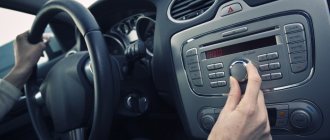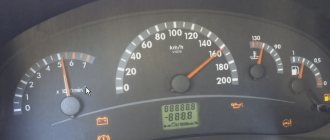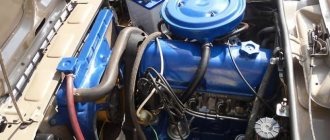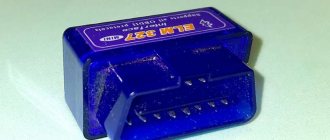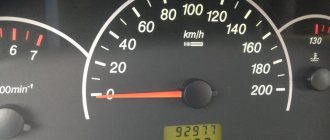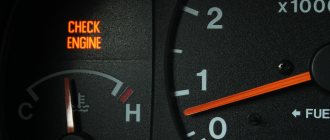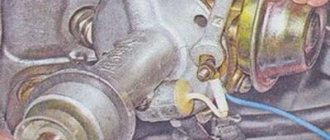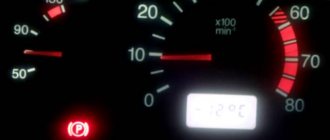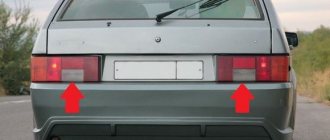The translation of the expression “check engine” in Russian literally sounds like “check the engine.” The “check” icon is on the dashboard of most modern cars, but its meaning remains unclear to many. Therefore, if this icon is yellow or orange engine icon - appears and does not disappear (or simply blinks), an inexperienced driver has a natural question: “what does this mean?” Next, we’ll try to find out the reasons why the check engine light came on on the dashboard of your car, as well as how to get rid of it.
Initially, this light indicated problems with the carburetor, but now that cars are equipped with full-fledged on-board computers, the message may indicate various malfunctions. For example, a “check engine” error may indicate problems with the quality of the air-fuel mixture or ignition faults, as well as many other things. Messages can be caused by both minor and critical failures.
Thus, when the “check engine” light is on, it is only clear that the ECU has detected a malfunction in one of the car’s systems. Only diagnostics can give a complete picture. Next, we will look at the main reasons why the check engine light is on and what needs to be done about it.
TOP 10 reasons why the check engine light came on
- The fuel tank cap is open . Check if it is closed tightly.
- Bad gasoline . The system can respond to fuel quality. The solution would be to drain the gasoline and fill it with better quality.
- Oil level . First of all, check its level with a dipstick. Also look for cracks in the block and oil leaks.
- Problems with the fuel pump or strainer in the tank. Check that the pump runs smoothly and does not make any unusual sounds.
- Dirty injectors . Eliminated by cleaning the injectors.
- Faulty high voltage wires or coils.
- Problem with spark plugs . The icon also lights up if there are problems with the spark plugs. It is worth checking the performance of the spark plugs and, if necessary, replacing them.
- No spark in one of the cylinders.
- The lambda probe is faulty . The problem can only be eliminated by replacing this unit with a new one or installing a blende; occasionally cleaning helps.
- Catalyst failure . Also solved by replacing the catalyst.
Only the main reasons and ways to solve them are listed here. In fact, there are many more of them. Diagnostics of the on-board computer, which controls all vehicle systems, can give a more complete picture of the current situation.
Check engine is not hidden on the dashboard of the Madza CX-5
Check engine on the Peugeot Partner panel is hiding in the left corner
Diagnosis of the cause
If the power unit is malfunctioning, it needs to be diagnosed. You can do this yourself or entrust the car to specialists. In the second option, detailed computer diagnostics will be carried out.
Attention! If you are diagnosing the engine yourself, then you must do this in compliance with safety precautions.
Algorithm of actions:
- Determine the “sick” cylinder. Turn on the ignition, open the hood and listen to the engine. The sound needs to be remembered. When the slave cylinder is turned off, strong tripping will begin. This will reveal the source of the problem.
- Check the spark plugs. They will need to be unscrewed and inspected. If damaged, the element will need to be replaced.
- Measure how much air enters the cylinder. Its disadvantage is the reason for the motor tripping. To do this, you need to check the air filter. If it is clogged, then replacement is necessary.
- Determine the volume of fuel entering the cylinder. For this purpose, it is necessary to measure the pressure in the fuel system. The procedure is carried out in several stages. If the reading is below normal, then the fuel pump components or pressure valves have probably failed.
At the final stage of diagnosis, you need to measure the compression in the cylinder with a compression gauge. It must be inserted into the spark plug hole of the faulty cylinder, turn on the ignition and gradually increase the pressure in the engine. Repeat this step several times. If the compression rate has decreased by 15%, then it is due to wear on the piston, valve or piston ring. The damage can only be corrected by disassembling the power unit.
How to remove check engine
Let's take a closer look at the steps that need to be taken first of all in order to get rid of the Check Engine indicator that lights up. The priority action algorithm will be as follows:
- Check if the gas tank cap is closed . The situation is especially relevant if you have just left the gas station, and soon after that the check engine icon comes on. This means that either the tightness of the fuel system has been broken due to the tank cap not being screwed tightly enough, or the quality of the fuel leaves much to be desired.
- Check the condition of the spark plugs . To do this, unscrew them and visually assess their condition. Very often, it is the spark plugs that cause the Check Engine light to come on. In particular, the reason may be that they begin to pass current due to carbon deposits on the electrodes. This coating is formed as a result of the high content of metals or other conductive substances in the fuel. An error may also occur if the gap between the electrodes on the spark plug exceeds a distance of 1.3 mm. We will look separately at diagnosing candles and how to do it based on their color. You will also find information about replacing them useful.
- Oil level. If the check engine light only lights up when the engine warms up, stop and listen, you may hear extraneous sounds from the engine. Check the engine oil level with a dipstick and add it if necessary. Also check for oil leaks.
- If your car is equipped with sensors for the purity of process fluids (motor oil, fuel, etc.), then the indicator may light up if the corresponding indicators exceed the permissible limit . The solution is to replace the appropriate filters or completely liquids if they do not meet the standards.
- Resetting the negative terminal from the battery ( 15...20 seconds ). After this, the Check Engine light should go out and the clock on the computer should reset to zero. This method may be relevant in two cases. The first is a banal “glitch” of the ECU. The second is if a large number of small errors have accumulated in the memory of the electronic unit and have not been reset. (usually they are caused by the use of low-quality gasoline, the presence of harmful impurities in the fuel-air mixture, moisture on electrical contacts, etc.).
The most convenient way is not to reset the terminal, as all settings in the car are reset, but to use a multi-brand scanner, such as Rokodil ScanX
.
After all, this is an inexpensive option that is compatible with 99% of cars manufactured in 1993, and it also fully supports all the functionality of popular diagnostic programs for smartphones. Whatever block there is an error in, you will not only reset it, but also see approximately the reason for the occurrence. If, after performing the above steps, the Check Engine indicator does not go out, or goes out, but soon lights up again, this means that the error lies deeper, and in order to eliminate it, additional detailed diagnostics must be carried out using more serious means.
Why does the “check” light up: the most common and common malfunctions
So, we figured out the general scheme. Now let's look at what problems lead to the check light coming on and the engine stalling. Often a p0300 error occurs, which indicates that a misfire (misfire) is occurring. There are several reasons for these omissions, and to determine them it is necessary to carry out a step-by-step diagnosis, taking into account certain individual symptoms.
- You should start by checking the ignition system. The most common cause of tripping is the failure of spark plugs and armored wires. Candles can wear out their service life, break down, or become heavily contaminated. Armored wires suffer from insulation damage and breakdowns. One way or another, the result is either no spark at all, or there is a spark, but it’s weak.
If everything is in order with the spark plugs and wires, you should pay attention to the ignition module or ignition coils, which may be shorting. In this case, it is better to entrust the check to experienced specialists, since unprofessional actions lead to the fact that you can burn the switch or damage other important elements.
It should also be added that you need to carefully inspect the spark plug wells themselves. Quite often, the engine fails if water accumulates in the wells or engine oil gets there. In some cases, lubricant gets into the wells due to problems with the valve cover gasket.
- Having dealt with the ignition system, it is necessary to check the power system. As a rule, incorrect operation of injection nozzles or malfunctions in their operation lead to engine tripping. At the same time, the check will light up or flash.
We also recommend reading the article about what misfires in engine cylinders are. In this article, you will learn about the causes of misfires and errors, as well as how to identify and fix the problem.
The best option would be to check the injectors on a special stand. Such diagnostics allows you to determine the need to clean, repair or replace injectors. At the same time, specialists check the power supply to the injectors, the condition of the injector O-rings, etc.
- As for compression, a burnt-out valve often leads to an unexpected decrease in the indicator. If the valve burns out, the engine starts to run rough. In this case, tripling is constant and occurs in all modes of engine operation. Engine thrust drops significantly, and significant excess fuel consumption is observed.
Please note that in this case you cannot drive the car, as there is a high risk of damaging the catalyst and oxygen sensor (lybda probe). To confirm the diagnosis, you need to measure the compression, and to solve the problem itself, you need to remove the cylinder head, troubleshoot the head and change the valve.
The check engine light is on - what should I do next?
You can try to find out the reason yourself by counting the number of blinks of the “check” and check the technical documentation for the designation of such an error code. For different cars there are different intervals between flashes and different codes by which they are interpreted.
Most of the errors that the indicator tells you about are not critical . You can perform diagnostics in two ways - yourself and by visiting a service station. The fact is that to obtain information in this case, you need special equipment or at least software for a smartphone.
But first of all, you need to find out how the car’s behavior changed after the error appeared. This is done in order to determine whether it is possible to drive with the check engine light on the panel, or whether it is better not to do this so as not to aggravate the problem.
| Car behavior | Icon is lit continuously | The check is blinking |
| Engine power and throttle response remain the same | You can keep moving | |
| No additional warning lights came on on the instrument panel. | ||
| The engine has become less responsive, the speed does not rise above a certain value (engine operation in emergency mode) | You can continue moving | The movement cannot be continued |
The car suddenly changed its behavior:
| The movement CANNOT be continued. | |
Along with the check engine icon, another indicator came on:
| ||
When does the check engine light come on?
We find out the reason why the check light is on
The error code can be read using a laptop with special software. The computer is connected via a cable to the machine's ECU and diagnostics are carried out. Also, using a laptop, you can enter additional external commands into the control unit or correct (reset) errors that appear.
A simpler method is to download an ECU communication and analytics program to your Android smartphone (for example, TORQUE, it has free and paid versions). And a Bluetooth adapter (car scanner) is connected to the electronic unit, which allows you to read information from the device. If you don’t have a laptop or you simply don’t want to bother installing additional software, you can delegate the described procedures to service station workers. They have all the necessary equipment and programs.
It must be remembered that each car (and sometimes each ECU on the same cars, but different years of manufacture) has a different list of error codes . Therefore, after receiving the information, you must have a standard set of diagnostic error codes (Diagnostic Trouble Code - DTC). You can find it in additional literature on diagnostics or on the Internet (for example, on thematic forums dedicated to your car model).
Another common cause for injection engines is problems with the injectors. In particular, the appearance of a significant amount of sediment on them. The solution to this problem is to clean the injectors. If problems occur with spark plugs, injectors, or the activated check engine indicator, the following symptoms may occur:
- weak engine thrust;
- high fuel consumption;
- jerks when accelerating or unstable operation of the engine;
- “floating” engine speed at idle.
The next step is to check the pressure in the fuel system. To do this you need to use a pressure gauge. The standard pressure for most non-tuned cars is 3 atmospheres (kgf/cm2). However, check this information in the registration certificate of your car. If the pressure is significantly lower, then the problem may lie in a faulty fuel pump or dirty injectors. If the pressure is constantly low, check the fuel pump. If at first it is normal, but drops shortly after starting the engine, check the injectors. Also pay attention to the mesh in the gas tank.
It is also worth checking the insulation of high voltage wires . It is better to do this not visually, but using a tester turned on in ohmmeter mode. wire insulation value at least 0.5 MOhm . Otherwise, the wire must be replaced.
If the Check Engine light comes on after you turn the key, and then goes off a few seconds later, this means that the system is performing a self-diagnosis and there is no cause for concern.
How to get to the service station when the Check Engine light is on
When driving to a service station, try to maintain a gentle driving regime. In particular:
- do not exceed speed more than 60 km/h;
- do not exceed engine speed more than 2500 rpm;
- turn off the air conditioner (heater), multimedia system and other currently unnecessary equipment that creates additional load on the engine;
- Avoid sudden starts and braking, drive smoothly.
You can return to normal driving only after diagnosing and eliminating the identified errors.
Motor trouble: signs
If the engine starts to stall, the check engine blinks. But the indicator does not always work, so other signs of malfunction must be taken into account. For example:
- engine vibration increases. This is very noticeable at idle and cold speeds. If this phenomenon becomes permanent, then one of the cylinders has failed. But such damage occurs gradually, so not everyone detects it in time. This method is used in later stages of breakdown;
- spark plugs have changed color. If you remove them, you will notice that the head has become dark. This is due to carbon deposits and soot due to the lack of ignition of the mixture. This indicates obvious problems. Even with prolonged use of candles, their color changes slightly, but there is no soot;
- fuel consumption has increased - you need to immediately pay attention to the engine;
- The engine has become less powerful, which is noticeable when moving. It operates on three cylinders. Therefore, if at least one fails, the engine does not have enough torque resource;
- unstable exhaust sound, which is complemented by vibrations in the body;
- When accelerating or moving evenly, the car began to twitch.
Attention!
You need to listen to how the engine works. If it starts to stall at medium or high speeds, then the valves are probably not functioning properly. One possible reason is an increased gap between them.
If at least one of the listed signs of breakdown appears, immediate action must be taken. If the engine starts up and the check light comes on, blinks and goes out, the driver may face a more complex problem in the near future. Specialists can fix it. In this case, repairs will be labor-intensive and financially costly.
What's the result?
As you can see, if the engine is running and the check mark is flashing, the cause should be determined as soon as possible. Timely contacting service or repairs will avoid subsequent problems with the catalyst and lambda.
Please remember that triplets and misfires do not always indicate a serious problem. In some cases, replacing the spark plugs or BB cables may be sufficient, while in others the engine still requires repair.
In this case, the spark on the spark plugs will be normal, the injectors will also supply fuel, the compression test will not reveal any deviations from the norm, but in this case the “check” will continue to blink or blink.
Long-term use of the vehicle
If a check mark starts flashing on a VAZ car with high mileage, then the reasons for tripling the power unit are as follows:
If the above procedures have been completed and the powertrain is still running, we recommend that you:
- Carry out ECU diagnostics. If necessary, replace it with a new disk.
- Check the injectors and the entire fuel system.
- Check the functionality of the oxygen sensor. If the device is faulty or damaged, repair work is carried out.
- The crankshaft position sensor fails - in this case, the ECU generates an error indicating this malfunction.
Why does an engine error occur?
In order to understand why an engine error occurs when a car is running on gas, you should know that modern power units are stuffed with all kinds of sensors that monitor the optimal operation of both the engine itself and the entire car as a whole. All these sensors transmit a huge amount of information to the on-board computer of a modern car (or, as it is commonly called, an electronic control unit). The ECU, based on sensor readings, adjusts engine operation, selecting the optimal operating mode for any situation.
After installing the LPG, the car begins to work both on gasoline (before the engine warms up to the required temperature) and on gas. It should be understood that operation on a gas mixture is significantly different from a gasoline mixture, and accordingly, inconsistencies in engine operation are possible. If, after installing the LPG, the electronic brain of the car is not “told”, any discrepancy about the new type of fuel will cause an error.
Cylinder failure
In case of stable or unstable engine operation, it is recommended to check the cylinder. Its malfunction is associated with failure of the spark plugs, oxygen sensor and ECU. The cylinder may fail instantly or gradually. In the first case, the VAZ engine's fuel consumption increases, engine power decreases, and vibration increases.
If the car is not repaired in a timely manner, the engine may fail. This is due to the fact that gasoline constantly flows into the broken cylinder, which mixes with oil and goes into the crankcase. With such a long process, the latter substance liquefies, losing its properties. The parts of the power unit begin to work in emergency mode, wearing out and forming chips.
If the check is flashing, use a VAZ engine, then you need to follow the following recommendations:
- start the power unit;
- open the hood;
- remove the wires from the spark plugs one by one.
The next step is to check the condition and functionality of the spark plugs. To do this, you need to unscrew the spark plugs with a special key. If there is a burn on the head and the electrode is clean and intact, the engine failure is due to dust getting into the cylinder. In this case, it is recommended to check the air supply system through the filter.
If the entire head is burned and the electrode is completely burned out, then a detonation fire has occurred and the ignition system is empty. If the head is covered with smoke, but the electrode is intact, the mixture entered the ignition system late. By assessing the condition of the spark plugs, you can determine the exact cause of the cylinder failure. To check the performance of spark plugs, it is recommended to use the “spark” method. If it breaks, the test continues. If there is no spark, the spark plugs are replaced with new analogues. A good spark requires starting the VAZ and monitoring the dynamics of changes.
How to diagnose the problem?
There are many other possible reasons why the check light comes on and the car does not pull. However, using a car scanner to independently diagnose cars of any brand, you can identify error codes in a situation where the problem does not appear immediately or at times. Even if the check appears only for a short time, the problem code will be stored in the ECU for a long time for subsequent retrieval of on-board information by the diagnostic computer.
We also watch the video, the main reasons why the car does not pull:
Primary signs of on-board voltage sag
In the most advanced cases, a drop in on-board voltage can be noticed without any measuring instruments. The primary signs of this defect include the following symptoms:
- chronic undercharging of the battery;
- audio system sound clipping;
- dim headlights;
- dashboard flashing during peak loads;
- floating engine speed.
For normal charging of the battery from the generator while driving, the voltage in the on-board network must be maintained at about 14.4 V. If due to drawdowns it is less, then the battery is never fully charged, may fail during a cold start of the engine, and also deteriorates as a result of sulfation of the lead plates.
Clipping is a type of sound distortion that occurs when the amplifier's output voltage exceeds the supply voltage. Most often it manifests itself in the form of wheezing from the speakers when the volume is turned up.
Dim lighting or flickering lights indicate that the lamps simply do not have enough voltage to operate at full capacity.
As for floating engine speeds, this is more often observed on cars with numerous electronics and various sensors. There is not enough voltage to operate all this, and the engine control system malfunctions when there are significant drawdowns in the on-board network.
